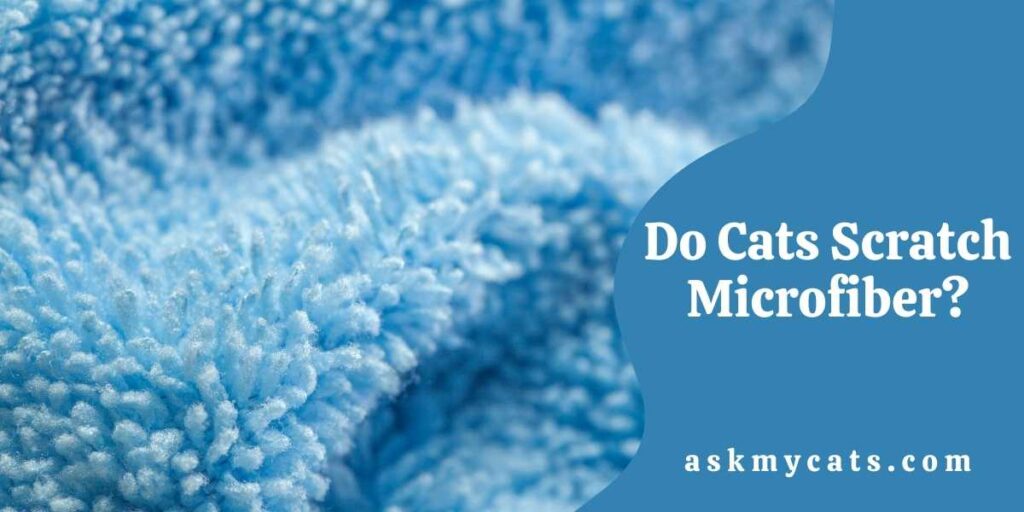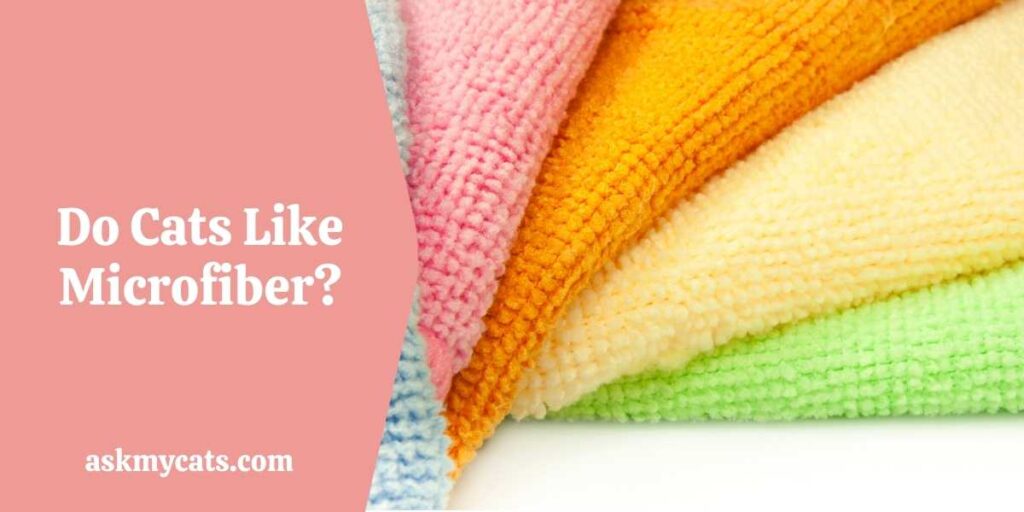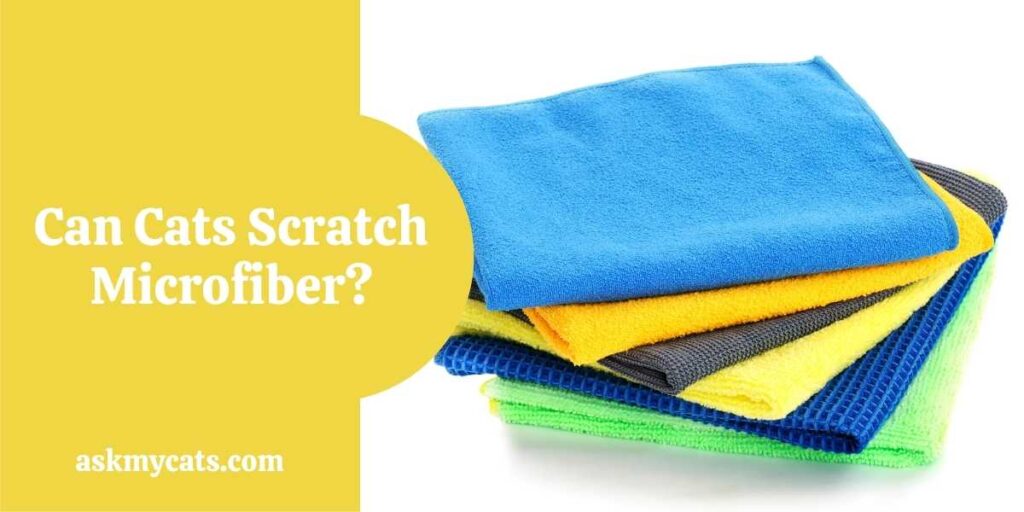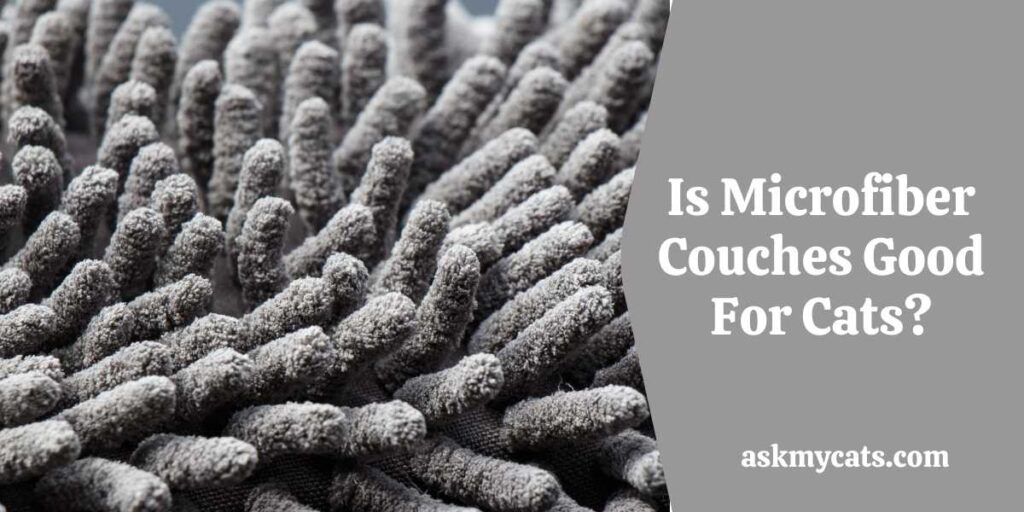Cat owners are always on the lookout for furniture that won’t be used as a scratching post. Many pet owners have found that microfiber furniture is scratch-resistant and simple to clean.
Cats don’t scratch microfiber since it’s soft and attractive while being durable. Even if your cat claws at it, microfibre can withstand a few scratches.
Now, let’s jump to more conclusions about whether a cat will scratch microfiber materials or not.


Give Your Cat the Perfect Day
Get the Free Ebook!
Do Cats Like Microfiber?
Cats don’t like microfiber material.

Faux materials such as suede and synthetics no longer have the reputation of being unfashionable and are now more popular than ever owing to changes in design trends and fabric texture upgrades.
Cat parents should avoid “loose-weave or looped upholstery,” such as linen and wool, and stick with textiles that are “tightly woven.” Why? Because your cat will think “cat toy!” when he sees those small loops or nubby threads.
This rule of thumb also applies to textiles on armchairs, dining chair pads, and floor coverings. Cats are not prejudiced. If given the chance, they’ll scratch every item of furniture that attracts their attention.
Microfiber is a synthetic fabric. Its fibres are tightly woven together and treated, resulting in a fabric that is smooth, robust, and moisture-resistant. It has a suede-like appearance.
Scratching and sharpening their claws is a natural inclination for cats. They favour objects that they can cling to with their claws. Because cat claws cannot penetrate microfiber, scratching is not a pleasurable experience.
Because of its smoothness, microfiber does not readily collect dirt and dander from cats. Cat hair will lay on the surface of the material but will not become entrenched. Any hair should be removed using a vacuum or a lint roller.
Cats prefer microfiber because it is silky and comfy to sleep on. They may not love clawing the cloth, but it does not imply they will not enjoy sleeping on it.
Because each cat is unique, their sensitivities to microfibre may differ. Provide a scratching post for the cat and keep its nails clipped and coat cleaned for optimal results. If pets are well-cared for, microfiber furniture will last longer.
Can Cats Scratch Microfiber?
Cats cannot scratch microfiber.

Cat claws may ruin fabric upholstery in addition to creating scratch scars on leather. Microfiber, a synthetic, velvety suede-like material, is said to be a decent option by some cat owners.
It’s softer and less enticing to cats than knits or woven fabrics into which they may dig their claws. Fur from cats, for example, may be readily cleaned from microfiber using a vacuum, lint roller, or towel. Microfiber may also be cleaned on the spot.
Microfiber is a strong, long-lasting fabric that your cat won’t tear to tears. Microfiber is an excellent alternative if you’re searching for a versatile and economical cloth that your cat is less likely to scratch.
The basic textile is made up of a blend of nylon and polyester spun into very fine strands. Microfiber is smooth and great for keeping your feline’s claws away from your furniture, whereas your cat is interested in stray threads.
Microfiber is used for a variety of things other than just decorating your home, such as:
- Cleaning rags and cloths
- Mops
- Bedsheets and pillowcases
- Curtains
- Clothing
- Towels
- Blankets
Because microfiber is a versatile material that can be used for a variety of purposes, you may use it to tidy up your home while worrying less about your cat’s destructive inclinations.
If you have a dirty cat, microfiber is also readily available in a variety of colours and has an easy-to-clean surface. In the end, it’s a less expensive alternative to buying leather and suede materials that are nonetheless robust and less likely to get tangled in your cat’s claws.
Is Microfiber Couches Good For Cats?
Microfiber couches are suitable for cats because they would not be able to scratch and damage them.

Microfiber or microsuede is another fantastic fabric option for cat owners. These textiles are less expensive than leather and are made of very thin, densely woven threads that cats find difficult to dig into. However, it tends to attract hair, so choose an upholstery colour that matches your cat’s fur.
Traditional textiles may quickly deteriorate when cats share furniture. Pet owners praise leather and microfiber for their ability to keep their pets looking good for years. Your budget, cleaning requirements, and pet’s behaviours will all influence which fabric is ideal for you.
While microfiber and leather are more durable than standard fabric upholstery, if your pet is a frequent visitor to your furniture, you may need to replace items every few years.
Leather is more costly than microfiber and comes in a variety of textures, from protectant-infused hide to buttery-soft material that shows pet wear more quickly.
Microfiber comes in a variety of textures, from Ultrasuede, which has a subtle leather-like feel, to more classic textures like velvet, denim, chenille, and twill.
Cats who scratch furniture will be lured to the softness of microfiber, but the ultrafine synthetic fibres are less likely to tear than traditional textiles, allowing your cat’s nails to glide straight through.
When a scratching post is easily available as an option, most cats shun leather. Although cat claws can harm leather, scratches can be removed with a polishing cloth.
You may even choose distressed-look leather, which hides marks almost completely. Micro-suede and most other microfiber textiles may be readily brushed clean of cat claw marks.
Hair is readily wiped away from leather, which does not attract or gather pet hair on its flat surfaces. Even if your cat isn’t permitted up on the couch, pet hair adheres to most microfiber weaves and gathers on the sides and front.
Microsuede fabric draws the least amount of hair of any microfiber, and hair may be readily removed with a moist cloth or vacuum.
Wipe away dust monthly and condition as needed to keep leather in good shape. Although microfiber may be cleaned, pet dander and dust are never entirely eliminated from between the strands, making the sofa more susceptible to a kitty odour over time.
Some microfibers on your cat’s coat can stain from oils and dust, causing discoloured spots. Check the label before purchasing microfiber furniture to see if it can be cleaned with water or solvent-based treatments, or if it can only be vacuumed.
Do Cats Scratch Microfiber Furniture?
Cats don’t scratch microfiber furniture.
Cat claws cannot pierce metal frames on furniture; thus, they are unlikely to harm it. Microfiber fabrics created from ultra-fine polyester and nylon threads are ideal for upholstery.
Because the microscopic strands are truly bound together, forming a lightweight, thick, water-resistant substance, this sort of cloth is stain and spill-resistant.
Microfiber, sometimes known as microsuede, ultrasuede, or fake suede, is a popular choice for couches and chairs. The density of the material allows it to withstand the abuse of a cat’s claws while simultaneously making it less tempting to scratch on.
Check that the cloth you want to choose is comfortable for you. When you sit on leather in the winter, it might feel slippery and chilly, and it can adhere to your bare legs in the summer.
If you don’t mind sitting on a cotton throw, you can simply remedy both issues. Because some weaves stretch with continuous usage by pets nestling into them, microfiber pillows and cushions can become deformed over time.
How To Fix Cat Scratches On A Microfiber Couch?
You can fix cat scratches on a microfiber couch by following these steps:
- Remove the cushion covers from your microfiber furniture and throw them in the washer. Fill the machine halfway with boiling water.
- Half the regular amount of laundry detergent should be added to the water. Allow the washing machine to finish the cycle.
- Place the cushion covers in the dryer after washing them in the washer. Dry them for 20 minutes on high heat, or until they are totally dry.
- Working in one direction only, softly clean the scratches using an isopropyl alcohol swab. Spray the scratches lightly with isopropyl alcohol in a spray bottle and clean them with a soft, dry white cloth as an option.
- Aim a medium-heat blow dryer to the region you just wiped. Watermarks may be avoided by drying it right away.
- Wipe in one direction until the scratches are gone, then blow dry immediately.
Frequently Asked Questions
Is microfiber cat scratch resistant?
First and foremost, microfiber is an excellent choice since it is both soft and elegant while also being durable. Microfiber can withstand a few scratches if your cat claws at it.
Do cats scratch faux leather?
Microfiber is the greatest sort of fabric for cats who scratch furniture since it is scratch resistant. If you really want the look of leather, though, imitation leather is a fantastic alternative.
Do cats scratch Ultrasuede?
With complete upholstery and recessed legs, cats won’t want to damage furniture. Ultrasuede and leather are the ideal textiles since they can’t be clawed through. Tweeds, for example, are a snag-prone fabric. Pet hair is also difficult to remove from textured textiles of this sort.
Final Words
Scratching and sharpening one’s nails are a natural habit for cats. They choose materials that allow them to hook their claws into. Scratching is not nice on these material since cat claws cannot penetrate microfiber.
Ask your questions in the comments section below.
